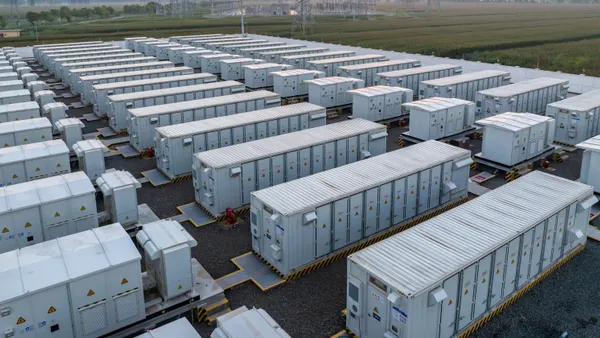Dive Brief:
-
Global energy storage capacity could amount to 741 GWh by the end of the decade, representing a 31% compound annual growth rate, analysis from Wood Mackenzie has found — and the U.S. could make up nearly half of that.
-
The average cost of lithium-ion battery cells is expected to drop during that timeframe, according to IHS Markit, falling below $100 per kWh in the next three years and potentially dipping to as low as $73 per kWh by the end of the decade.
-
Utilities are increasingly including battery storage in their procurement, but there are still obstacles around compensating owners of storage more directly for the value of their storage, ranging from small residential installations to large industrial uses, said Peter Miller, the Western region director for the climate and clean energy program at the Natural Resources Defense Council (NRDC). "[I]t would be helpful to the system if we could improve the price signals, the economics of those installations and compensate them," Miller added.
Dive Insight:
While energy storage is still a relatively new market, consumers and equity investors are continuing to eye investments in the sector, according to Wood Mackenzie, despite the COVID-19 pandemic and associated economic turmoil.
Investment decisions might be delayed in some cases, but the need for energy storage and the broader transition in the power market that’s driving them have not changed, Rory McCarthy, a principal analyst with the energy storage team at Wood Mackenzie, said in a statement.
"If anything, the transition may be accelerated as governments around the world grapple with how to recover their economies more sustainably than in the past with upside for the energy storage industry," McCarthy added.
The Wood Mackenzie report looked at non-pumped hydro energy storage, according to McCarthy, predominantly lithium-ion batteries. It did find a 17% decrease in global deployments for this year as compared to the outlook prior to the COVID-19 pandemic, representing a reduction of around 2 GWh compared to previous projections. But while Wood Mackenzie anticipates wavering growth in the early part of the decade, "growth will likely accelerate in the late 2020s, to enable increased variable renewable penetration and the power market transition," McCarthy said.
The U.S. will make up a large chunk of that cumulative capacity — 365 GWh, or 49%, according to the report. Utility resource planning is anticipated to play a large role, given the policy-driven shift towards renewables and storage in the last couple of years. According to the report, the front-of-the-meter storage sector in the U.S. is set to surge through next year, before slowing down a little towards the middle of the decade. After 2025, with wholesale market revenue streams growing and utility investments balancing out, growth will become steadier, Wood Mackenzie projects.
Falling prices
At the same time, the average cost of lithium-ion batteries is projected to continue falling, per IHS Markit, after having already dropped 82% since 2012.
The projections are based on three individual forecasts, Sam Wilkinson, associate director of clean technology and renewables at IHS Markit, said in an email: material costs, manufacturing costs and energy density. Manufacturing costs, or the cost of combining all the materials into a complete cell, is the most important driver of falling prices, Wilkinson added, and will be achieved by scaling up to larger manufacturing facilities with greater economies of scale, better throughput and improved and more efficient manufacturing techniques.
Battery storage is one of the most important enablers to transition to renewables, Wilkinson noted, adding, "As battery costs have fallen quickly, and will continue to do so, the combination of batteries with renewables is beginning to be cost competitive, and standalone batteries are also starting to compete with conventional resources to provide the crucial grid services that help to keep the grid stable."
There’s still a lot of work that needs to be done to improve regulatory frameworks to allow battery storage to fully participate in the market systems, according to NRDC’s Miller. Once the economic incentives are in place though, Miller expects to see a lot more investment in the space.
"There’s a complicated interplay of federal and state and local regulatory frameworks that need to be navigated to get there," Miller added.
Easier integration in California
Last week, the California Independent System Operator’s Board of Governors approved energy storage and distributed energy resource enhancements which will make it easier to integrate those resources, the ISO said in a press release. CAISO expects more than 1,500 MW of battery and hybrid resources to connect to the grid by the end of 2021, which will be "an important component of a reliable and clean electricity grid" given their potential to shift excess solar generation from the middle of the day to the evening.
CAISO is working to increase the storage on its system, while facing the overwhelming priority of ensuring reliable power, Miller noted.
"So what they try to do is to bring on those storage resources but in a way that they can fully use those to meet system needs, and can count on them to meet system needs."
In some ways, the storage sector is in a horse race of different technologies, according to Miller.
"It’s still early, but I think this decade is going to be in some ways the decade of storage, now that solar and wind is so inexpensive."













